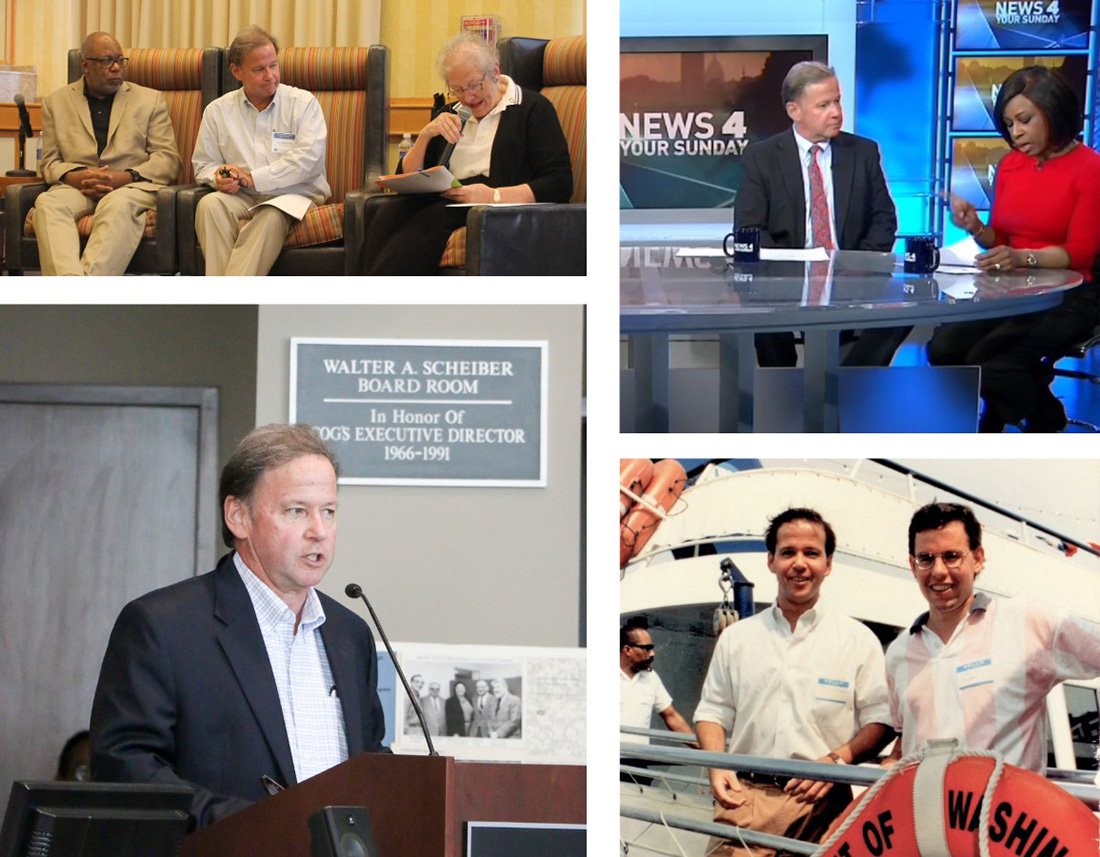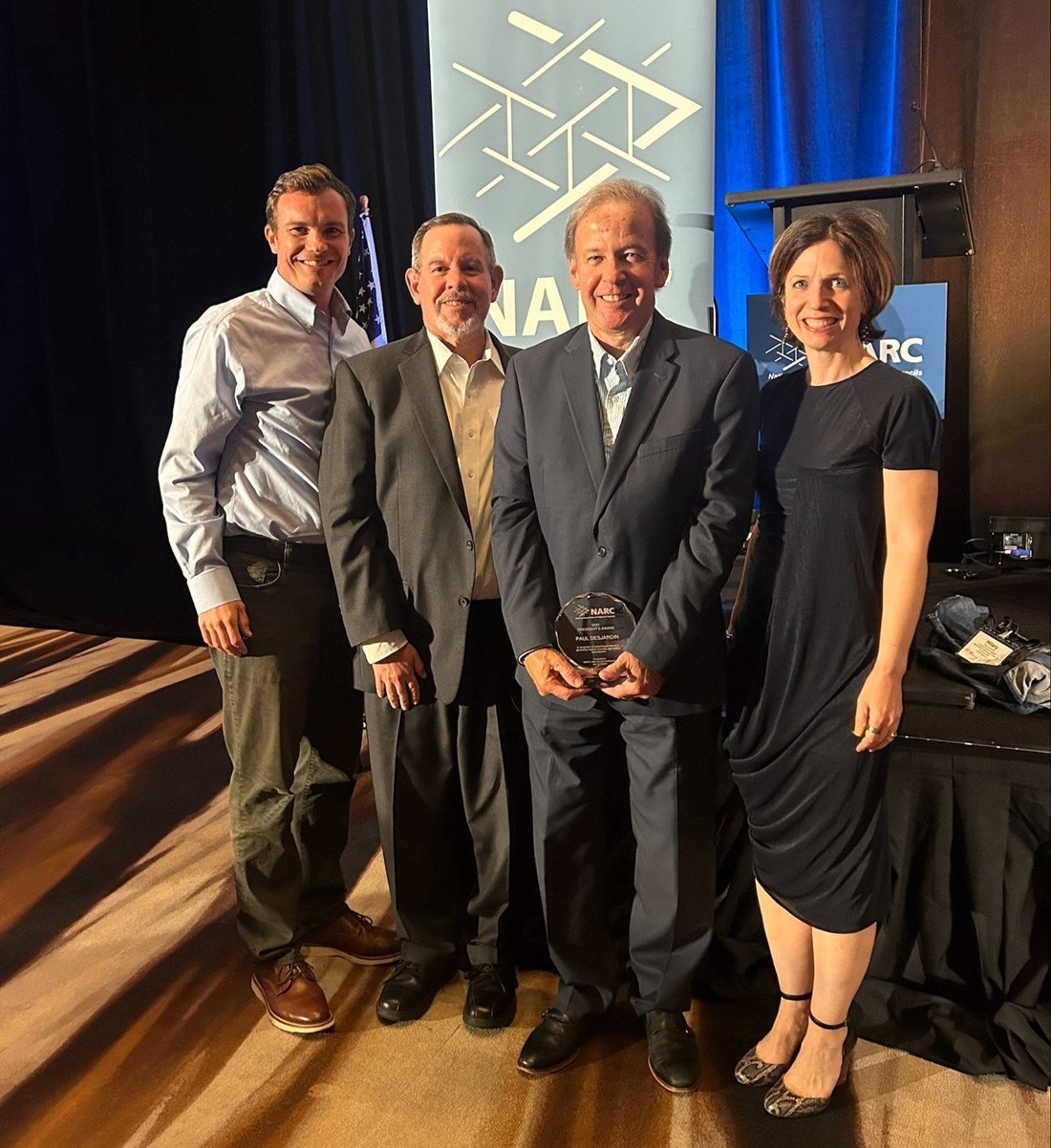When Paul DesJardin came to COG as an intern in 1983, metropolitan Washington’s population was around 3 million—nearly half of what it is today—and Metro was just under ten years old, in the midst of major construction work that would spread the system beyond downtown DC and into suburban Maryland and Virginia.
And while the region has undergone remarkable change, many of the issues that connect area jurisdictions, like economic growth and development, housing, and transportation, remain top priorities requiring close collaboration and support by COG and its professional experts like DesJardin. As he retires as Director of the Department of Community Planning and Services (DCPS) this month capping a 40-year career, COG is celebrating DesJardin and highlighting many of the valuable planning initiatives and programs that he’s had a hand in.

Clockwise from top left: Paul DesJardin participates as a panelist at a COG Leadership Retreat; DesJardin appears as a guest on an NBC4 public affairs program; DesJardin and COG Planning Data and Research Program Director Tim Canan attend a COG staff group outing; DesJardin speaks to COG Board.
Laying the building blocks for the region
DesJardin began his time at COG “in the minutia” of data, developing long-range growth forecasts of population, household, and employment growth in the region for use in planning activities—known as COG’s Cooperative Forecasting Program. It was in this work that he observed the uneven pattern of anticipated future growth and the mismatch between expected employment growth and residential growth, leading to discussions on the regional transportation consequences of these patterns and the need to focus more future growth in compact, mixed-use centers in transportation corridors that efficiently could be served by transit and other alternative transportation options.
Working closely with colleagues at COG who he credits for “always being able to have the big picture in mind,” DesJardin was part of the team that identified Regional Activity Centers, marrying the work of the Transportation Planning Board (TPB) to plan and fund transportation projects with COG’s economic and population forecasts. Ultimately, these actions set the stage for “smart growth” initiatives to take hold on a regional scale—strategically investing transportation funding in rapidly growing communities that would, in turn, heavily utilize these infrastructure investments.
Building regional consensus and implementing these initiatives was not easy, and localities were sometimes hesitant in embracing regional planning activities that they felt could undermine their own locally-driven initiatives. DesJardin’s diplomacy helped open the door for local jurisdictions to come to the table and unify around smart growth planning on a regional scale.
Working in close partnership with local planning directors, a joint COG/TPB working group was convened to establish a collective understanding of the Regional Activity Centers initiative and establish a policy and technical framework under which these centers would be identified, refined, and updated. In 2002, after two years of extensive collaboration and dialog, 180 “regional” and “local” Activity Centers were identified that (1) contained approximately 80 percent of the region’s employment and 20 percent of the region’s housing, and (2) are now actively used in both regional and local planning studies and have been embraced as a concept beyond local government staff. (COG is currently working with its jurisdictions on the latest Activity Centers update this year.)
DesJardin points out that many of these adopted Activity Centers (Tysons and Bethesda, for example) were at the time known as “edge cities,” bolstered significantly by Reagan-era policies in the 1980s that shrunk the federal workforce and rapidly expanded procurement dollars for private defense and other federal contractors. In the matter of a few years, sleepy towns in the region were transformed with new residents, traffic, and more.
Navigating and evolving beyond a “federal town” identity
The DC region’s unique relationship with the federal government can at times be a double-edged sword—often providing economic stability while making our region particularly vulnerable to the whims of federal decisions. Despite a diversified employment pool over the last few decades (including the region’s growth as a technology hub) DesJardin asserts that the region is very much still a “federal town,” impacted significantly as federal activities, and dollars, shift and evolve.
This reality has driven much of metropolitan Washington’s planning initiatives over the years. Reflecting on some of the most difficult times for the region during his tenure, DesJardin points to base realignment and closure activities in the early-2000s. Following 9/11, the federal government shifted much of its workforce away from Crystal City in Arlington, VA, and onto other bases and cities across the United States in an effort to increase security. Conversely, the region was cushioned just a few years later from the sweeping impacts of the great recession in the mid-2000s.
“DC was almost a safe zone, everyone came here to manage the recession,” reflected DesJardin.
The direct impact of federal government activities meant COG planning needed to be nimble and flexible, while centered around a strong vision for future growth—regardless of the presence (or absence) of federal dollars. Around this time, there was also growing interest among area leaders to coalesce around a set of ambitious goals and targets to guide future decisions and measure progress, which led to the multi-year development of COG’s Region Forward Vision that was endorsed by local governments and several civic and nonprofit organizations in 2010. DesJardin and his team oversaw this effort and created the Region Forward Coalition—a multi-sector group focused on advancing the vision for a more prosperous, accessible, livable, and sustainable region.
Anticipating the swinging economic pendulum
Bringing these voices together, unified around a shared vision for the region, has been crucial to sustaining a thriving region. DesJardin notes the “swinging pendulum” of issues the region has faced over the years—particularly on housing.
The Regional Activity Centers work highlighted the need to increase the supply of housing in the region and in the early 2000s, staff analyses had identified risky patterns in lending, leading to COG hosting a predatory loan conference in 2006.
Just a few years later, the housing “bubble” would pop, and the foreclosure crisis would hit the nation, which again catapulted affordable housing to the front of everyone’s minds. Despite being insulated from some of the greatest economic impacts of the Great Recession, the DC region was still home to two jurisdictions with some of the highest foreclosure rates in the nation in 2009.
Thankfully, the groundwork had been laid to ensure prompt regional action on this issue. DesJardin worked closely with COG leadership, the Nonprofit Roundtable of Greater Washington, and other stakeholders across the region to form the Capital Area Foreclosure Network (CAFN), which among other activities, provided grant funding to regional housing nonprofits.
About a decade later, DesJardin and his department were involved in convening the region’s housing and planning directors to develop regional housing targets for 2030, which call for more affordably priced housing in or near activity centers and high-capacity transit locations. These housing targets, adopted by the COG Board in 2019, have been widely supported by member jurisdictions and are being actively incorporated in local planning efforts today.
Repeatedly, DesJardin homed in on activities that shored up the region’s “economic defenses” against unknowns, predicting the ever-swinging pendulum of economic growth and downturn. These efforts continue today, with the Housing Affordability Planning Program, which through COG’s partnership with the Amazon Housing Equity Fund, provides flexible grants to area local governments and non-profit developers engaged in the planning, approval, or development of housing near transit stations.
Looking forward on DesJardin’s legacy
Over the course of DesJardin’s 40-year tenure, his work has been driven by his understanding of the region’s full potential. As a fourth-generation Washingtonian, he brought firsthand experience of witnessing how drastically the DC region can evolve, and looked forward to the future to anticipate how his own children’s lives in the region would look.
He recognized early on in his career that a unified vision, and commitment to collaboration, among the region’s localities and other stakeholders would be key to unlocking this potential.
DesJardin says it was COG that demonstrated this approach to him first, and says he is frequently amazed that COG is involved in nearly every issue impacting the region. He says it’s this aspect of COG--and the talent of his colleagues around him--that has inspired his work year after year.

Paul DesJardin receives 2024 President's Award from the National Association of Regional Councils (NARC). June 2024.